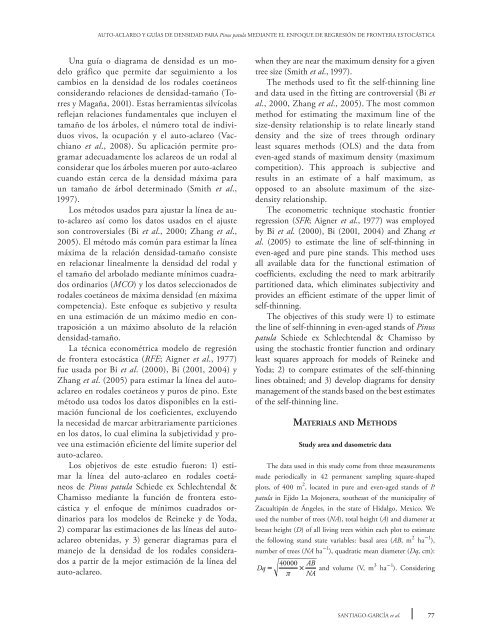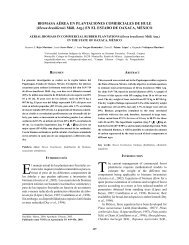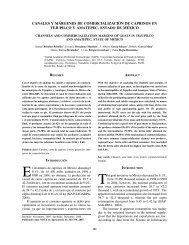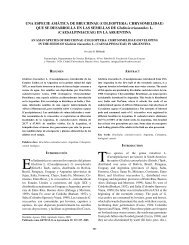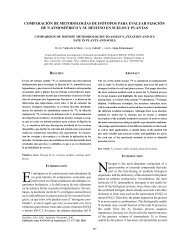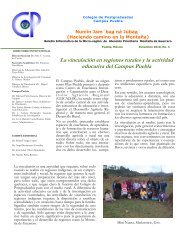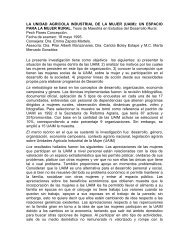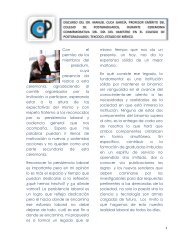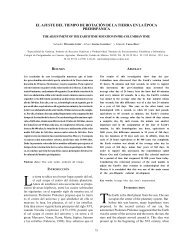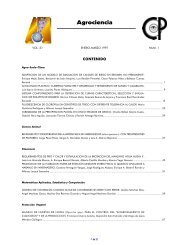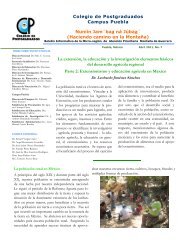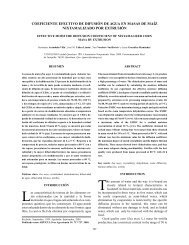AUTO-ACLAREO Y GUÍAS DE DENSIDAD PARA Pinus patula ...
AUTO-ACLAREO Y GUÍAS DE DENSIDAD PARA Pinus patula ...
AUTO-ACLAREO Y GUÍAS DE DENSIDAD PARA Pinus patula ...
You also want an ePaper? Increase the reach of your titles
YUMPU automatically turns print PDFs into web optimized ePapers that Google loves.
<strong>AUTO</strong>-<strong>ACLAREO</strong> Y <strong>GUÍAS</strong> <strong>DE</strong> <strong>DE</strong>NSIDAD <strong>PARA</strong> <strong>Pinus</strong> <strong>patula</strong> MEDIANTE EL ENFOQUE <strong>DE</strong> REGRESIÓN <strong>DE</strong> FRONTERA ESTOCÁSTICA<br />
Una guía o diagrama de densidad es un modelo<br />
gráfico que permite dar seguimiento a los<br />
cambios en la densidad de los rodales coetáneos<br />
considerando relaciones de densidad-tamaño (Torres<br />
y Magaña, 2001). Estas herramientas silvícolas<br />
reflejan relaciones fundamentales que incluyen el<br />
tamaño de los árboles, el número total de individuos<br />
vivos, la ocupación y el auto-aclareo (Vacchiano<br />
et al., 2008). Su aplicación permite programar<br />
adecuadamente los aclareos de un rodal al<br />
considerar que los árboles mueren por auto-aclareo<br />
cuando están cerca de la densidad máxima para<br />
un tamaño de árbol determinado (Smith et al.,<br />
1997).<br />
Los métodos usados para ajustar la línea de auto-aclareo<br />
así como los datos usados en el ajuste<br />
son controversiales (Bi et al., 2000; Zhang et al.,<br />
2005). El método más común para estimar la línea<br />
máxima de la relación densidad-tamaño consiste<br />
en relacionar linealmente la densidad del rodal y<br />
el tamaño del arbolado mediante mínimos cuadrados<br />
ordinarios (MCO) y los datos seleccionados de<br />
rodales coetáneos de máxima densidad (en máxima<br />
competencia). Este enfoque es subjetivo y resulta<br />
en una estimación de un máximo medio en contraposición<br />
a un máximo absoluto de la relación<br />
densidad-tamaño.<br />
La técnica econométrica modelo de regresión<br />
de frontera estocástica (RFE; Aigner et al., 1977)<br />
fue usada por Bi et al. (2000), Bi (2001, 2004) y<br />
Zhang et al. (2005) para estimar la línea del autoaclareo<br />
en rodales coetáneos y puros de pino. Este<br />
método usa todos los datos disponibles en la estimación<br />
funcional de los coeficientes, excluyendo<br />
la necesidad de marcar arbitrariamente particiones<br />
en los datos, lo cual elimina la subjetividad y provee<br />
una estimación eficiente del límite superior del<br />
auto-aclareo.<br />
Los objetivos de este estudio fueron: 1) estimar<br />
la línea del auto-aclareo en rodales coetáneos<br />
de <strong>Pinus</strong> <strong>patula</strong> Schiede ex Schlechtendal &<br />
Chamisso mediante la función de frontera estocástica<br />
y el enfoque de mínimos cuadrados ordinarios<br />
para los modelos de Reineke y de Yoda,<br />
2) comparar las estimaciones de las líneas del autoaclareo<br />
obtenidas, y 3) generar diagramas para el<br />
manejo de la densidad de los rodales considerados<br />
a partir de la mejor estimación de la línea del<br />
auto-aclareo.<br />
when they are near the maximum density for a given<br />
tree size (Smith et al., 1997).<br />
The methods used to fit the self-thinning line<br />
and data used in the fitting are controversial (Bi et<br />
al., 2000, Zhang et al., 2005). The most common<br />
method for estimating the maximum line of the<br />
size-density relationship is to relate linearly stand<br />
density and the size of trees through ordinary<br />
least squares methods (OLS) and the data from<br />
even-aged stands of maximum density (maximum<br />
competition). This approach is subjective and<br />
results in an estimate of a half maximum, as<br />
opposed to an absolute maximum of the sizedensity<br />
relationship.<br />
The econometric technique stochastic frontier<br />
regression (SFR; Aigner et al., 1977) was employed<br />
by Bi et al. (2000), Bi (2001, 2004) and Zhang et<br />
al. (2005) to estimate the line of self-thinning in<br />
even-aged and pure pine stands. This method uses<br />
all available data for the functional estimation of<br />
coefficients, excluding the need to mark arbitrarily<br />
partitioned data, which eliminates subjectivity and<br />
provides an efficient estimate of the upper limit of<br />
self-thinning.<br />
The objectives of this study were 1) to estimate<br />
the line of self-thinning in even-aged stands of <strong>Pinus</strong><br />
<strong>patula</strong> Schiede ex Schlechtendal & Chamisso by<br />
using the stochastic frontier function and ordinary<br />
least squares approach for models of Reineke and<br />
Yoda; 2) to compare estimates of the self-thinning<br />
lines obtained; and 3) develop diagrams for density<br />
management of the stands based on the best estimates<br />
of the self-thinning line.<br />
mAteRIAls And methods<br />
Study area and dasometric data<br />
The data used in this study come from three measurements<br />
made periodically in 42 permanent sampling square-shaped<br />
plots, of 400 m 2 , located in pure and even-aged stands of P.<br />
<strong>patula</strong> in Ejido La Mojonera, southeast of the municipality of<br />
Zacualtipán de Ángeles, in the state of Hidalgo, Mexico. We<br />
used the number of trees (NA), total height (A) and diameter at<br />
breast height (D) of all living trees within each plot to estimate<br />
the following stand state variables: basal area (AB, m 2 ha 1 ),<br />
number of trees (NA ha 1 ), quadratic mean diameter (Dq, cm):<br />
Dq<br />
40000 AB<br />
= ×<br />
π NA<br />
and volume (V, m 3 ha 1 ). Considering<br />
SANTIAGO-GARCÍA et al.<br />
77


